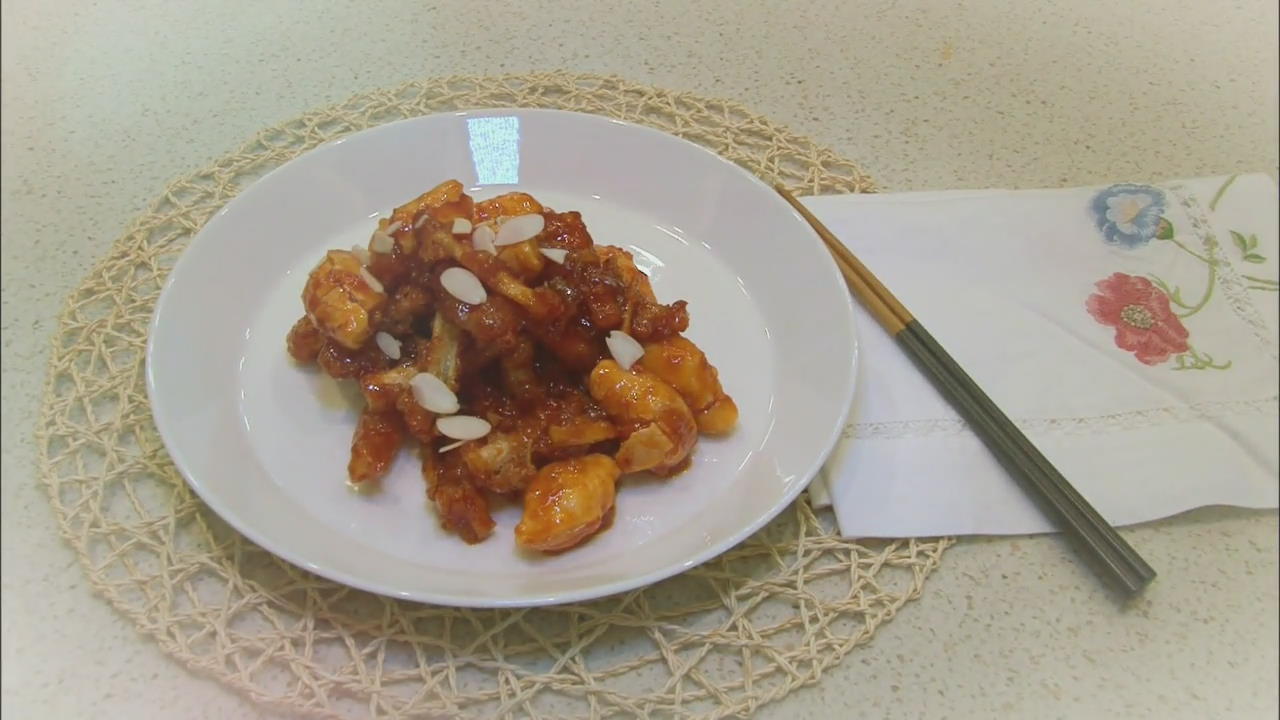Balloon Flower Roots
입력 2017.09.04 (14:04)
수정 2017.09.04 (14:12)
읽어주기 기능은 크롬기반의
브라우저에서만 사용하실 수 있습니다.
[Anchor Lead]
It seems that cool and crisp autumn weather has finally arrived. And while it may feel like the perfect time for outdoor activities, it’s during the change in seasons in which you’re most likely to catch a cold. Balloon flower roots are a common natural remedy here in Korea, and it’s harvest season right now. Let’s check it out.
[Pkg]
The field is dotted with purple blossoms. Koreans eat the root of this flower called balloon flower or bellflower. Balloon flower roots are crunchy and bitter. They can be eaten raw or incorporated into various dishes. The tiny roots are packed with nutrients.
[Soundbite] Prof. Lee Hye-ran(Baewha Women's Univ.) : "The main ingredient of the roots is saponin which helps to expand blood vessels and lower blood pressure. It also lowers blood sugar and cholesterol levels. The roots are also frequently used as a medicinal ingredient as it works to melt away phlegm which is a key symptom of respiratory diseases contracted during seasonal transition."
The roots are rich in saponin as well as vitamins and minerals which boost our immune system. Balloon flower roots called Doraji in Korean are in the peak of harvest time these days. A tractor passes through and the white roots emerge from the crumbling soil. The roots have absorbed all their nutrients from the ground. The substance saponin is particularly abundant in the finer roots of doraji. Thus the more fine roots, the better. First we'll sample a taste of the roots just gathered from the field. The roots are cleaned and then seasoned with red chili-pepper paste and vinegar. A glass of the Korean rice wine makgeolli is the best accompaniment. It appears the day's work ends here.
[Soundbite] Lee Suk-ja(Jeollanam-do Prov. Resident) : "It's soft and crunchy and not bitter. It's really good."
For those who don't like the bitterness, there are ways to make this less so. Sprinkle some salt and sugar on the roots that have been cleaned. Add some water too and use your fingers for the vegetable to absorb the ingredients. Then let it still for a while.
[Soundbite] Park Ji-ye(Culinary Researcher) : "When the salt and sugar are absorbed into the roots, they serve to release the bitter taste through osmotic pressure. The roots also become softer with a salty, sweet taste."
Balloon flower roots eaten raw are very crunchy in texture. But this time we'll try frying them for even more crispness. Sprinkle flour on the roots so the fry batter can stick well. The batter is made with regular flour mixed with glutinous rice flour. The roots get a coating and are dropped into sizzling oil one by one. The frying sound is almost melodious. Crunchy doraji root fries are now ready! The fries can also turn into a candied treat with a coating of delicious seasoning. For the seasoning, various veggies including onions and carrots are minced and pan fried in olive oil. Add chili pepper paste and ketchup to this mixture as well as sugar, oligosaccharide, sesame oil and cooking wine, as the whole thing is boiled down. Once the seasoning gets sticky, the fried roots are then coated in red. This is sweet and spicy candied balloon flower roots. Now another dish, doraji patties. To maintain the crunchiness, the roots are chopped into tiny bits. Minced pork and beef is added to the dough. Season the dough with various condiments. Then knead the dough and form the patties into whatever shape you like. It's grilling time now. Flip the patties up and down several times for thorough cooking. Balloon flower roots are tiny but super nutritious. Enjoy them while in season.\
It seems that cool and crisp autumn weather has finally arrived. And while it may feel like the perfect time for outdoor activities, it’s during the change in seasons in which you’re most likely to catch a cold. Balloon flower roots are a common natural remedy here in Korea, and it’s harvest season right now. Let’s check it out.
[Pkg]
The field is dotted with purple blossoms. Koreans eat the root of this flower called balloon flower or bellflower. Balloon flower roots are crunchy and bitter. They can be eaten raw or incorporated into various dishes. The tiny roots are packed with nutrients.
[Soundbite] Prof. Lee Hye-ran(Baewha Women's Univ.) : "The main ingredient of the roots is saponin which helps to expand blood vessels and lower blood pressure. It also lowers blood sugar and cholesterol levels. The roots are also frequently used as a medicinal ingredient as it works to melt away phlegm which is a key symptom of respiratory diseases contracted during seasonal transition."
The roots are rich in saponin as well as vitamins and minerals which boost our immune system. Balloon flower roots called Doraji in Korean are in the peak of harvest time these days. A tractor passes through and the white roots emerge from the crumbling soil. The roots have absorbed all their nutrients from the ground. The substance saponin is particularly abundant in the finer roots of doraji. Thus the more fine roots, the better. First we'll sample a taste of the roots just gathered from the field. The roots are cleaned and then seasoned with red chili-pepper paste and vinegar. A glass of the Korean rice wine makgeolli is the best accompaniment. It appears the day's work ends here.
[Soundbite] Lee Suk-ja(Jeollanam-do Prov. Resident) : "It's soft and crunchy and not bitter. It's really good."
For those who don't like the bitterness, there are ways to make this less so. Sprinkle some salt and sugar on the roots that have been cleaned. Add some water too and use your fingers for the vegetable to absorb the ingredients. Then let it still for a while.
[Soundbite] Park Ji-ye(Culinary Researcher) : "When the salt and sugar are absorbed into the roots, they serve to release the bitter taste through osmotic pressure. The roots also become softer with a salty, sweet taste."
Balloon flower roots eaten raw are very crunchy in texture. But this time we'll try frying them for even more crispness. Sprinkle flour on the roots so the fry batter can stick well. The batter is made with regular flour mixed with glutinous rice flour. The roots get a coating and are dropped into sizzling oil one by one. The frying sound is almost melodious. Crunchy doraji root fries are now ready! The fries can also turn into a candied treat with a coating of delicious seasoning. For the seasoning, various veggies including onions and carrots are minced and pan fried in olive oil. Add chili pepper paste and ketchup to this mixture as well as sugar, oligosaccharide, sesame oil and cooking wine, as the whole thing is boiled down. Once the seasoning gets sticky, the fried roots are then coated in red. This is sweet and spicy candied balloon flower roots. Now another dish, doraji patties. To maintain the crunchiness, the roots are chopped into tiny bits. Minced pork and beef is added to the dough. Season the dough with various condiments. Then knead the dough and form the patties into whatever shape you like. It's grilling time now. Flip the patties up and down several times for thorough cooking. Balloon flower roots are tiny but super nutritious. Enjoy them while in season.\
■ 제보하기
▷ 카카오톡 : 'KBS제보' 검색, 채널 추가
▷ 전화 : 02-781-1234, 4444
▷ 이메일 : kbs1234@kbs.co.kr
▷ 유튜브, 네이버, 카카오에서도 KBS뉴스를 구독해주세요!
- Balloon Flower Roots
-
- 입력 2017-09-04 13:56:34
- 수정2017-09-04 14:12:03

[Anchor Lead]
It seems that cool and crisp autumn weather has finally arrived. And while it may feel like the perfect time for outdoor activities, it’s during the change in seasons in which you’re most likely to catch a cold. Balloon flower roots are a common natural remedy here in Korea, and it’s harvest season right now. Let’s check it out.
[Pkg]
The field is dotted with purple blossoms. Koreans eat the root of this flower called balloon flower or bellflower. Balloon flower roots are crunchy and bitter. They can be eaten raw or incorporated into various dishes. The tiny roots are packed with nutrients.
[Soundbite] Prof. Lee Hye-ran(Baewha Women's Univ.) : "The main ingredient of the roots is saponin which helps to expand blood vessels and lower blood pressure. It also lowers blood sugar and cholesterol levels. The roots are also frequently used as a medicinal ingredient as it works to melt away phlegm which is a key symptom of respiratory diseases contracted during seasonal transition."
The roots are rich in saponin as well as vitamins and minerals which boost our immune system. Balloon flower roots called Doraji in Korean are in the peak of harvest time these days. A tractor passes through and the white roots emerge from the crumbling soil. The roots have absorbed all their nutrients from the ground. The substance saponin is particularly abundant in the finer roots of doraji. Thus the more fine roots, the better. First we'll sample a taste of the roots just gathered from the field. The roots are cleaned and then seasoned with red chili-pepper paste and vinegar. A glass of the Korean rice wine makgeolli is the best accompaniment. It appears the day's work ends here.
[Soundbite] Lee Suk-ja(Jeollanam-do Prov. Resident) : "It's soft and crunchy and not bitter. It's really good."
For those who don't like the bitterness, there are ways to make this less so. Sprinkle some salt and sugar on the roots that have been cleaned. Add some water too and use your fingers for the vegetable to absorb the ingredients. Then let it still for a while.
[Soundbite] Park Ji-ye(Culinary Researcher) : "When the salt and sugar are absorbed into the roots, they serve to release the bitter taste through osmotic pressure. The roots also become softer with a salty, sweet taste."
Balloon flower roots eaten raw are very crunchy in texture. But this time we'll try frying them for even more crispness. Sprinkle flour on the roots so the fry batter can stick well. The batter is made with regular flour mixed with glutinous rice flour. The roots get a coating and are dropped into sizzling oil one by one. The frying sound is almost melodious. Crunchy doraji root fries are now ready! The fries can also turn into a candied treat with a coating of delicious seasoning. For the seasoning, various veggies including onions and carrots are minced and pan fried in olive oil. Add chili pepper paste and ketchup to this mixture as well as sugar, oligosaccharide, sesame oil and cooking wine, as the whole thing is boiled down. Once the seasoning gets sticky, the fried roots are then coated in red. This is sweet and spicy candied balloon flower roots. Now another dish, doraji patties. To maintain the crunchiness, the roots are chopped into tiny bits. Minced pork and beef is added to the dough. Season the dough with various condiments. Then knead the dough and form the patties into whatever shape you like. It's grilling time now. Flip the patties up and down several times for thorough cooking. Balloon flower roots are tiny but super nutritious. Enjoy them while in season.\
It seems that cool and crisp autumn weather has finally arrived. And while it may feel like the perfect time for outdoor activities, it’s during the change in seasons in which you’re most likely to catch a cold. Balloon flower roots are a common natural remedy here in Korea, and it’s harvest season right now. Let’s check it out.
[Pkg]
The field is dotted with purple blossoms. Koreans eat the root of this flower called balloon flower or bellflower. Balloon flower roots are crunchy and bitter. They can be eaten raw or incorporated into various dishes. The tiny roots are packed with nutrients.
[Soundbite] Prof. Lee Hye-ran(Baewha Women's Univ.) : "The main ingredient of the roots is saponin which helps to expand blood vessels and lower blood pressure. It also lowers blood sugar and cholesterol levels. The roots are also frequently used as a medicinal ingredient as it works to melt away phlegm which is a key symptom of respiratory diseases contracted during seasonal transition."
The roots are rich in saponin as well as vitamins and minerals which boost our immune system. Balloon flower roots called Doraji in Korean are in the peak of harvest time these days. A tractor passes through and the white roots emerge from the crumbling soil. The roots have absorbed all their nutrients from the ground. The substance saponin is particularly abundant in the finer roots of doraji. Thus the more fine roots, the better. First we'll sample a taste of the roots just gathered from the field. The roots are cleaned and then seasoned with red chili-pepper paste and vinegar. A glass of the Korean rice wine makgeolli is the best accompaniment. It appears the day's work ends here.
[Soundbite] Lee Suk-ja(Jeollanam-do Prov. Resident) : "It's soft and crunchy and not bitter. It's really good."
For those who don't like the bitterness, there are ways to make this less so. Sprinkle some salt and sugar on the roots that have been cleaned. Add some water too and use your fingers for the vegetable to absorb the ingredients. Then let it still for a while.
[Soundbite] Park Ji-ye(Culinary Researcher) : "When the salt and sugar are absorbed into the roots, they serve to release the bitter taste through osmotic pressure. The roots also become softer with a salty, sweet taste."
Balloon flower roots eaten raw are very crunchy in texture. But this time we'll try frying them for even more crispness. Sprinkle flour on the roots so the fry batter can stick well. The batter is made with regular flour mixed with glutinous rice flour. The roots get a coating and are dropped into sizzling oil one by one. The frying sound is almost melodious. Crunchy doraji root fries are now ready! The fries can also turn into a candied treat with a coating of delicious seasoning. For the seasoning, various veggies including onions and carrots are minced and pan fried in olive oil. Add chili pepper paste and ketchup to this mixture as well as sugar, oligosaccharide, sesame oil and cooking wine, as the whole thing is boiled down. Once the seasoning gets sticky, the fried roots are then coated in red. This is sweet and spicy candied balloon flower roots. Now another dish, doraji patties. To maintain the crunchiness, the roots are chopped into tiny bits. Minced pork and beef is added to the dough. Season the dough with various condiments. Then knead the dough and form the patties into whatever shape you like. It's grilling time now. Flip the patties up and down several times for thorough cooking. Balloon flower roots are tiny but super nutritious. Enjoy them while in season.\
이 기사가 좋으셨다면
-
좋아요
0
-
응원해요
0
-
후속 원해요
0











![[Korea Snapshot] Cheongsapo Skywalk](https://news.kbs.co.kr/data/news/2017/09/04/3544201_90.jpg)





이 기사에 대한 의견을 남겨주세요.